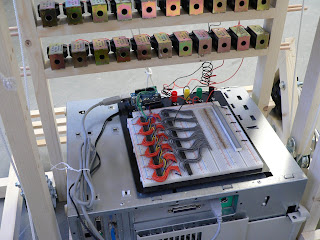
The robotic accordion / [Deep|Remote] Listening Device might actually be the first instrument in a strange electro-mechanical orchestra that tries to find music in everyday occurrences and processes that people do not normally notice. The following is a description of the orchestra. It informs the process of how an architectural proposal forms around my project.
The Surveillance Orchestra is a group of robotic musical instruments that finds and explores the music hidden in the banal, the mundane and the ordinary. The Orchestra uses surveillance devices to observe specific phenomena such as the movement of trains on a track, the traffic on a street, or the growth of a burdock plant. Each instrument of the orchestra is unique and responds to its own remote surveillance device or set of devices that observe its phenomenon of interest. The surveillance devices convert their observations into audible tones that can be periodically sent over radio to the orchestra instruments.

The owners of the instruments of the Surveillance Orchestra are a secretive and diverse group of hobbyists and amateur musicians. In Winnipeg, they have chosen a piece of city property in Point Douglas as the site of their observations. This is because of the variety of phenomena available to observe and to exploit the nature of Point Douglas as a forgotten neighborhood near the centre of the city. Someone skulking around and placing an object on a fence does not look quite so out of place in Point Douglas as they might in Tuxedo or Charleswood.
The owners of the instruments keep them tucked away at their homes where they continually revise and update the mechanisms, electronics and software of their devices. They constantly search for the best way to translate the surveillance data into a music appropriate for the surveilled phenomenon. Each member of the orchestra transmits the sounds produced by their instruments over a single (pirate) AM radio frequency (which changes periodically to help avoid detection by authorities).
Winnipeg’s Surveillance Orchestra started in 2007 with three members. The orchestra grew to twelve members by 2017 when their presence in Point Douglas was discovered by a CP Rail employee performing maintenance on one of the tracks. The employee did not usually work in the area, and questioned why there was such a large structure carrying cables over the tracks.

Each member of the orchestra constructs and adapts their own infrastructure in Point Douglas to accommodate their surveillance devices. Their constructions are primarily made of pieces of existing infrastructure that had been forgotten, abandoned or at least looked like they wouldn’t be missed if they were “borrowed.” The constructions start small and are built up slowly and covertly enough that locals scarcely notice the changes. Most parts are carried in by hand and no more than four visible pieces are installed during a week. Power for the devices is provided by solar panels and batteries, strategically placed to avoid theft and suspicion. The surveillance devices communicate to the orchestra instruments over Citizen’s Band (CB) radio, a mode of communication largely abandoned in favour of the cell phone.
















































